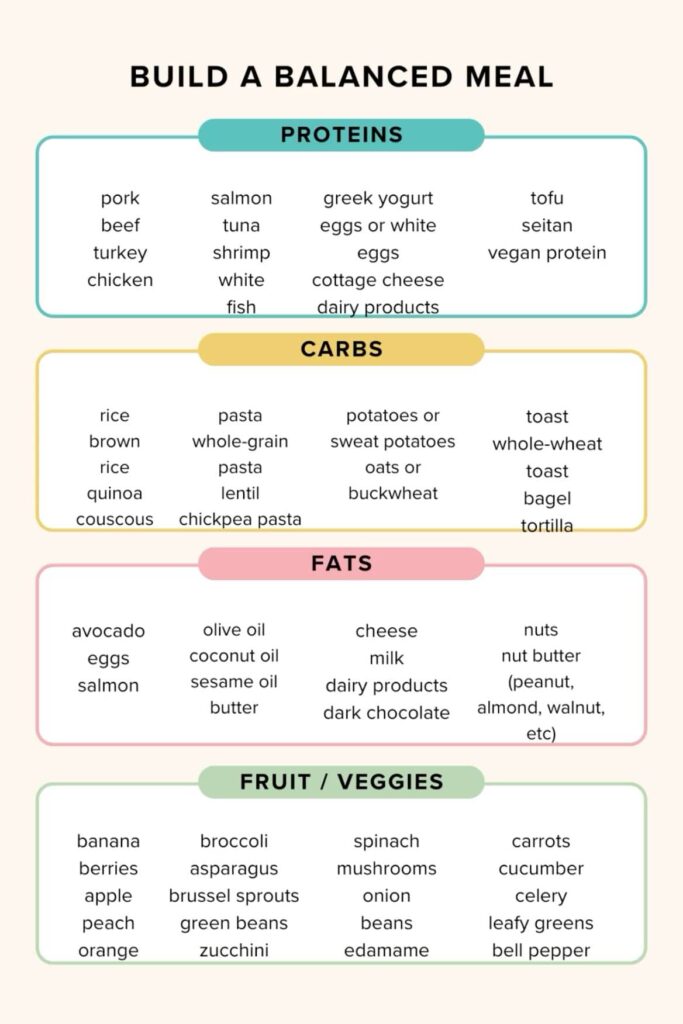How to Build a Balanced Meal: A Comprehensive Guide to Proteins, Carbs, Fats, and Veggies
Creating a balanced meal is essential for maintaining a healthy lifestyle. Whether you’re looking to lose weight, build muscle, or simply improve your overall health, understanding how to combine proteins, carbohydrates, fats, and fruits/vegetables is key. This guide will walk you through the components of a balanced meal, offering tips and examples to help you make informed choices.
Why Balanced Meals Matter
A balanced meal provides your body with the nutrients it needs to function optimally. Each macronutrient—protein, carbohydrates, and fats—plays a unique role in your health:
- Proteins: Essential for muscle repair, immune function, and hormone production.
- Carbohydrates: Your body’s primary energy source, crucial for brain function and physical activity.
- Fats: Important for hormone production, nutrient absorption, and providing long-lasting energy.
- Fruits and Vegetables: Packed with vitamins, minerals, and fiber, they support digestion and overall health.
By combining these elements, you can create meals that keep you full, energized, and nourished.
Building Blocks of a Balanced Meal
Proteins
Proteins are the building blocks of your body. Here are some excellent sources:
- Animal-Based Proteins: Chicken, turkey, beef, pork, salmon, tuna, shrimp, eggs, Greek yogurt, cottage cheese.
- Plant-Based Proteins: Tofu, seitan, lentils, chickpeas, edamame, vegan protein powders.
Tip: Aim to include a source of protein in every meal to support muscle maintenance and repair.
Carbohydrates
Carbohydrates are your body’s main energy source. Choose complex carbs for sustained energy:
- Whole Grains: Brown rice, quinoa, whole-grain pasta, oats, buckwheat, couscous.
- Starchy Vegetables: Potatoes, sweet potatoes.
- Legumes: Lentils, chickpeas, beans.
- Bread and Tortillas: Whole-wheat toast, bagels, tortillas.
Tip: Opt for whole, unprocessed carbs to maximize nutrient intake and avoid blood sugar spikes.
Fats
Healthy fats are crucial for overall health. Include a variety of sources:
- Oils: Olive oil, coconut oil, sesame oil.
- Nuts and Seeds: Almonds, walnuts, peanuts, nut butters (peanut, almond, etc.).
- Dairy: Cheese, milk, butter.
- Other Sources: Avocado, dark chocolate, eggs, salmon.
Tip: Incorporate healthy fats in moderation to support heart health and nutrient absorption.
Fruits and Vegetables
Fruits and vegetables are rich in vitamins, minerals, and fiber. Aim for a colorful variety:
- Fruits: Banana, berries, apple, peach, orange.
- Vegetables: Broccoli, spinach, carrots, cucumber, asparagus, Brussels sprouts, green beans, zucchini, mushrooms, onions, leafy greens, bell peppers, celery, edamame.
Tip: Fill half your plate with fruits and vegetables to ensure you’re getting a wide range of nutrients.
Sample Balanced Meals
Breakfast: Greek Yogurt Parfait
- Protein: Greek yogurt, nuts.
- Carbs: Oats, berries.
- Fats: Nuts, seeds.
- Fruits/Veggies: Berries, banana slices.
Instructions: Layer Greek yogurt with oats, nuts, and fresh berries. Top with a drizzle of honey for sweetness.
Lunch: Grilled Chicken Salad
- Protein: Grilled chicken breast.
- Carbs: Quinoa, whole-grain croutons.
- Fats: Olive oil dressing, avocado.
- Fruits/Veggies: Spinach, cherry tomatoes, cucumbers, bell peppers.
Instructions: Toss grilled chicken with quinoa, spinach, and chopped vegetables. Drizzle with olive oil and lemon juice.
Dinner: Salmon with Sweet Potato and Broccoli
- Protein: Salmon.
- Carbs: Sweet potato.
- Fats: Olive oil, avocado.
- Fruits/Veggies: Broccoli, asparagus.
Instructions: Bake salmon with a drizzle of olive oil. Serve with roasted sweet potato and steamed broccoli.
Snack: Apple with Nut Butter
- Protein: Nut butter.
- Carbs: Apple.
- Fats: Nut butter.
- Fruits/Veggies: Apple slices.
Instructions: Slice an apple and dip it in your favorite nut butter for a quick, balanced snack.
Tips for Building Balanced Meals
- Plan Ahead: Prepare your meals in advance to ensure you have all the necessary components.
- Portion Control: Be mindful of portion sizes to avoid overeating.
- Variety: Rotate different proteins, carbs, and vegetables to keep your meals interesting and nutrient-dense.
- Hydration: Drink plenty of water throughout the day to support digestion and overall health.
- Listen to Your Body: Pay attention to hunger and fullness cues to avoid overeating.
Conclusion
Building a balanced meal doesn’t have to be complicated. By incorporating a variety of proteins, carbohydrates, fats, and fruits/vegetables, you can create meals that are both nutritious and delicious. Remember, the key to a healthy diet is balance and moderation. Start experimenting with different combinations and find what works best for you. Happy eating!










